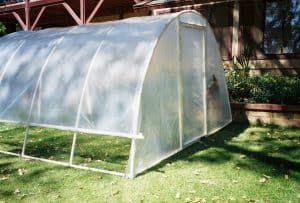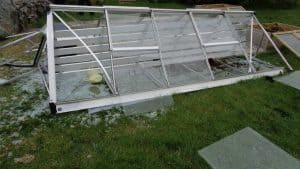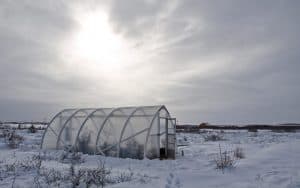So, you’ve decided to implement rain collection into your greenhouse construction plans – you think rain barrels are the way to go.

Well, they are. Rain barrels will catch the offshoots of water from your roof so that you can re-use it in your greenhouse. Some methods of rain collection are better than others, so keep reading to figure out the specifics about which types of rain barrels are best for your greenhouse.
Why collect rainwater?
In a typical one-inch rainfall, 600 gallons of water fall on a 1000-square-foot roof. That’s a lot of good, free, oxygenated water. Building a greenhouse is expensive, so why let all that free water go to waste?
Collecting rainwater for gardening has so many benefits.
Help the Environment
Clean, fresh, healthy water is not an endless resource, despite what we humans (especially in the Western world) might like to think. The more we incorporate sustainable, restorative habits into our lifestyle, the faster we can heal the damage industrialization and overpopulation have done to the planet.
Save Money
Your water bill can be a major expense that comes along with greenhouse operation. If you’re in a drought-stricken area, you might even have restrictions and rations on your water usage. Decrease your utility bill and avoid fines by harvesting rainwater.
Improve Plant health
Catch this: rainwater is better for your plants than tap water. Really!
Municipal water (even if you filter it) almost always contains additives, minerals, and chemicals that can harm your plants. Added fluoride is poison for plants. Chlorine, added to tap water as a disinfectant, can cause burnt leaves. Calcium and magnesium are necessary for plants, but these naturally occurring minerals in city water don’t do much good when sprayed leaves with sprinkler systems. Municipal water also often has added sodium to soften water, and high sodium can damage plants, their root systems, and the soil.
Rainwater, on the other hand, is much richer in nitrogen and oxygen than tap water (since that is mainly what the air around is composed of), which makes plants happy and healthy. That’s why rainwater smells so good and earthy! Oxygenated water helps prevent root systems from becoming waterlogged.
There’s more! Carbon dioxide in the air is “captured” (we won’t get into the actual chemistry of this) in condensing and falling rain, and when combined with other atmospheric minerals, it helps balance the pH of soil. A suitable pH helps plants get access to boosting minerals like zinc and iron.
Choosing a barrel
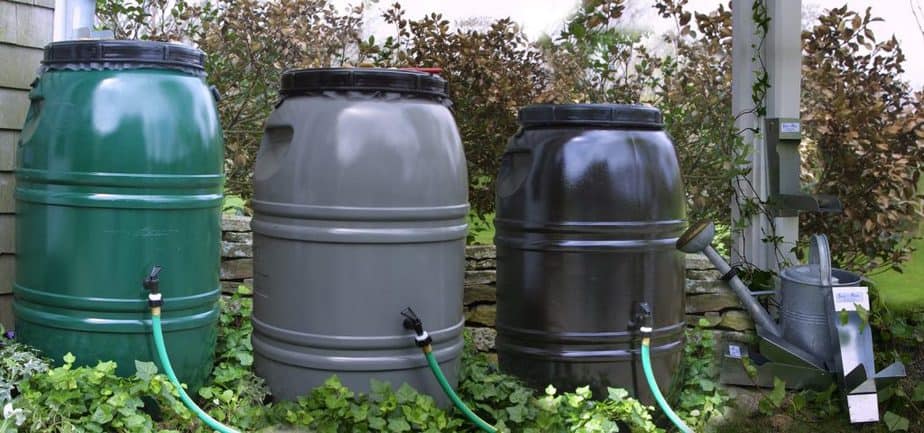
There are a lot of options for rain-catching barrels out there, so here are some guidelines when looking into acquiring your first one.
Mesh filter or lid
Always, always choose a water container with a lid and mesh filter so that leaves, bugs, and animals don’t get inside. Good quality rain barrels will have a slightly concave top to direct water flow toward an opening that is protected by a screen or filter.
You may want to grab another wire filter for the end of your downspout, too, to prevent the screen on top of your rain barrel from getting clogged quickly.
Upcycled
If you’re purchasing a used barrel (woohoo, reducing waste and being earth-friendly!) be diligent about finding out what the barrel was originally used for. Chemicals? Flammable stuff? Industrial oils? Not good. Wine? Bourbon? Cooking oil? Go for it. Look for a “food grade” barrel to be sure.
Of course, the barrel should be washed extensively with no residue before you start using it for rain catchment.
Soft-shell
The newest trend in rain collection devices is a collapsible, soft “barrel” or tank. These nifty creations can fold up when not in use and tend to be very durable.
Spigot
You’re going to need to get the water out of your rain barrel somehow. I know, it sounds obvious. But the gardeners who don’t think of this beforehand are severely disappointed once they realize it, so…you’re welcome. Ensure that the barrel you’re purchasing has a built-in spigot.
Aesthetically advanced
For the design-savvy gardener, more pricey but more aesthetically pleasing options are available, like brownstone or clay barrels, some with planters on top. These heavy monstrosities aren’t the ideal option for greenhouses. But they can still be useful for catching water from your roof and diverting it to a greenhouse with a hose or sprinkler.
Where to Place Your Rain Barrel
Many people will choose to place their rain collection barrels outside the greenhouse to save space inside for plants. Plus, it’s easier to direct rain flow into a barrel outside, right under the gutter drain pipe.
If you have a large enough greenhouse, though, you can undoubtedly store water barrels inside the greenhouse. But this is typically a choice for people who have a truly colossal greenhouse or those who want to use their rain-catching barrels as thermal batteries (electricity-free heating devices). Read more on water barrels as thermal batteries below.
Rain Collection Methods
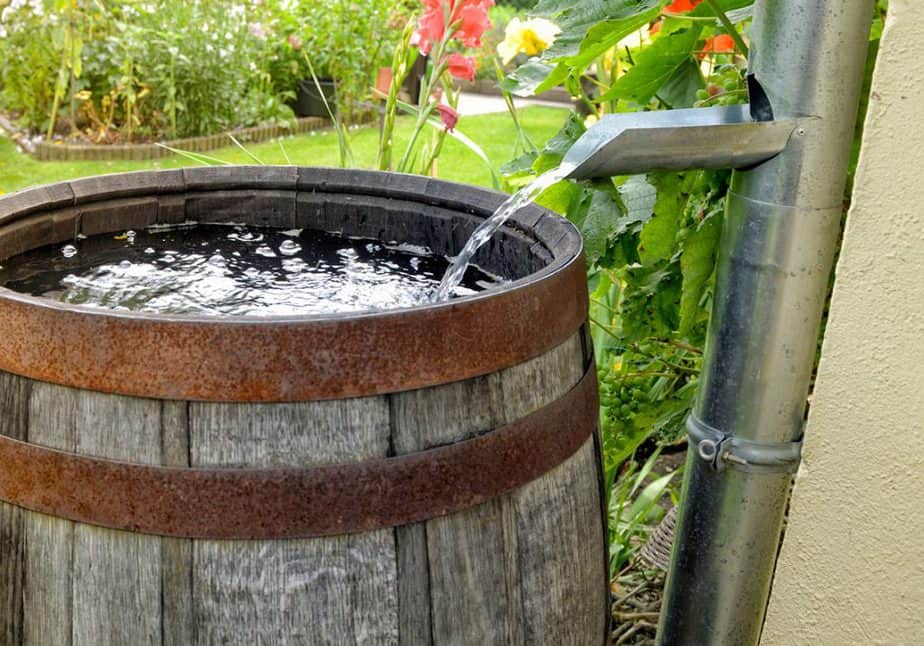
Getting rain from the roof into the barrel isn’t too complicated, but it will take a few more pieces of equipment and just a little bit of designing. Does a rain barrel require a permit or license? Usually, no. But, your greenhouse might.
Gutters
Obvious but necessary. Gutters are needed to catch the water as it flows off the peaked roof—whether that’s the roof of your greenhouse or your home.
You don’t want leaves, sticks, feathers, rocks, bugs, cats and dogs, or any other debris in your rain barrel. Install a gutter guard to start catching leaves before they travel into the downspout.
Downspout
Place a convenient downspout at the end of the gutter or pipe to more easily divert rainwater to straight into the barrel.
It can get truly annoying to try to position the barrel directly under a wall-attached gutter to get rain flowing inside without sloshing out, especially if you have a barrel with just a small opening at the top.
Some downspouts come with a diverter ready to go, like this one that even includes a built-in filter to catch leaves and other debris. Or, use a bigger downspout plus diverter if you have multiple barrels and a larger roof.
Diverter
There are all kinds of hoses, pipes, and other contraptions to help you direct rainwater from the gutter right into your barrel. If you’re having a hard time placing the barrel precisely beneath the gutter and downspout, grab a handy diversion kit with flexible piping to help.
Sure, this seems like an unnecessary add-on at first, but it will make collecting rainwater so much easier! This kind of diverter is also a great help if you want to bring water into the greenhouse through a hose or irrigation system, rather than a watering can. So many ways to optimize!
Want to go super DIY? Miss playing with LEGOs? Grab some PVC pipe and build it yourself.
Overflow attachment
In an average one-inch rainstorm, about 1,000 gallons fall on a 1,600-square-foot roof. Wow! Your rain barrel definitely does not hold 1,000 gallons – more like 55 gallons. Capture it with overflow or lose it!
An overflow attachment for a rain collection container is one of the most forgotten accessories but one of the most economical and environmentally friendly. Avoid wasted rainwater with an overflow pipe that directs excess rainfall into another barrel or storage area. Diverting overflowing rain away from your house’s foundation and/or the floor of your greenhouse is also essential.
Use an overflow pipe to connect another barrel (or even a smaller container) to the barrel that is your primary collection container—the one directly below the gutter. Or, if you just want to keep your building’s foundation from getting destroyed, use the overflow pipe to direct extra water away from the structure.
Other Accessories and Set-up
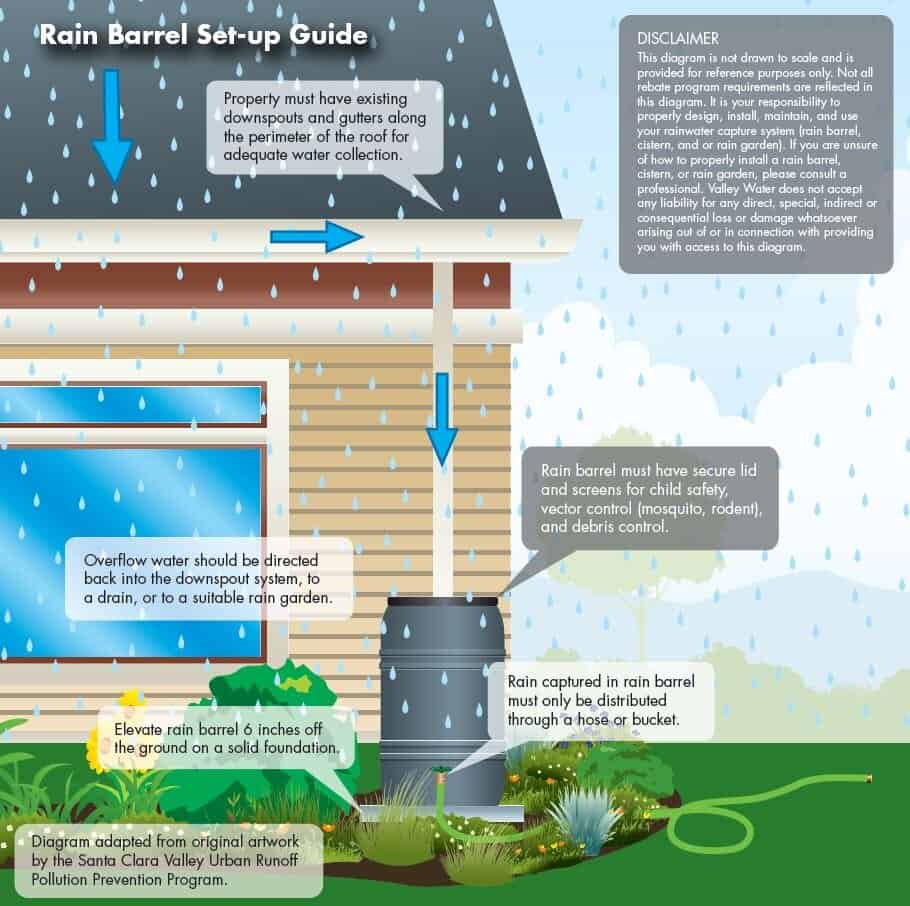
Barrel stand
A water barrel stand is essential for the easy operation of your water barrel. Elevating the barrel off the ground will give you space to place buckets, water cans, etc., under the spigot to fill.
Elevating the spigot higher can prevent the need for hunching or kneeling to collect your water container. Doing this can alleviate back or knee discomfort for gardeners who suffer from joint pain. This elevation is also useful for those doing vertical gardening in their greenhouse.
Raising the barrel will also increase water flow speed (gravity!), which keeps water moving in the barrel. Standing water within the barrel is just asking for yucky bacteria and mold to collect, especially in warmer weather.
There are a plethora of water barrel stands and wooden platforms that look fancy, but you can even place your rain barrel on a concrete block or large bricks.
Irrigation system
Get really fancy with an automated watering system. A drip irrigation system that uses gravity to draw water from the barrel to your plants can attach directly to your barrel’s spigot or another outlet to save you from lugging watering cans around or even using a hose to water.
Barrels as thermal batteries

Water has a super high heat capacity per volume, so it is extremely effective at storing up heat from the sun to keep your greenhouse warm. The downside of using barrels inside your greenhouse as heat batteries is the space they take up.
While you can install a solar electricity-powered heat system for your greenhouse, the easiest and more typical way to use water containers for heat is called “passive heat”—simply letting the water barrels absorb heat from the sun throughout the day. Read more about that in our overview of solar greenhouses.
Darker colored barrels will collect more heat. If you have a white or light barrel, paint it black. The energy efficiency is really worth the paint and the effort.
The south side of your greenhouse will be getting the most sun (if you built it correctly!) and heat the water most effectively. Place barrels on the south side of the house. If you have more than one water barrel, stack them up or place them close together to concentrate and conserve heat.
So, you have a method for heating your greenhouse. What about cooling and ventilating it? Learn more here.
Now you’re probably thinking, “Wait, if the rain barrel is inside, and the rain and the gutter is outside, then how do I get the rain inside the barrel?” True: you need to expend a bit of additional energy and equipment in the set-up if your barrel is inside. Typically, that just means a bit of extra downspout design and a big overflow pipe to direct water from a gutter through one of the greenhouse panes or vents. Read this if you need more information about choosing your greenhouse panes and vents.


